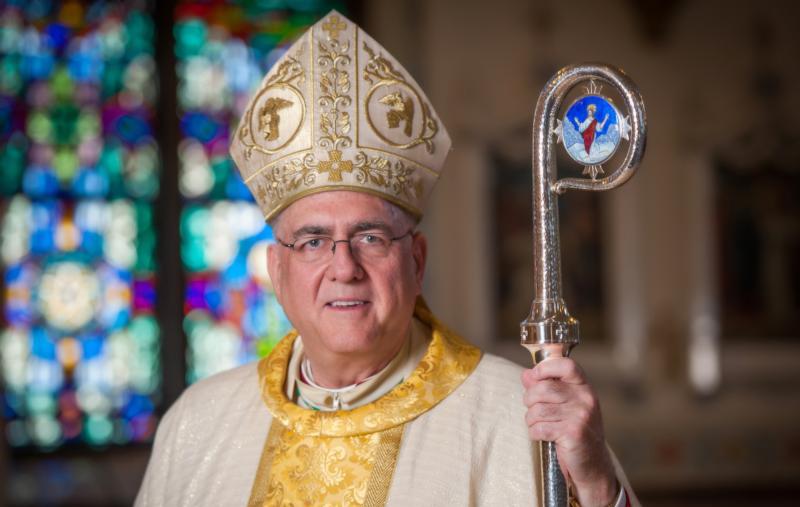
by Archbishop Joseph F. Naumann
The Passion narratives are true Christian literary treasures that provide the central core of what we believe as Catholics. This year for Palm Sunday we heard the Passion of St. Luke.
Luke begins by recounting the Last Supper, the first Eucharist. Jesus made clear that what he instituted that night was intimately connected with what would happen on Calvary. The Eucharist is the new Passover meal. Jesus is the lamb of sacrifice and his blood liberates his disciples from the enslavement of sin and the domination of death.
Amazingly, after the meal, Jesus’ apostles argued about which one of them should be considered the greatest. Their obtuseness, after all the formation Our Lord had provided them, must have been incredibly frustrating to Jesus.
At the same time, I find consolation in the honesty of the apostles in revealing their weaknesses and poverty. Jesus counseled them if they wished to follow him, then they must strive to be servant leaders.
Jesus urged the apostles to pray for strength for the trials that lay before them. Instead, they fell asleep. Again, this is consoling for modern disciples as we struggle to be vigilant in our own prayer. Jesus prayed with intensity to the Father, asking him to remove the cup of suffering that is now imminent.
However, in the end, Jesus, unlike the first Adam in the Garden of Eden, desired to do the Father’s will above everything else. St. Luke is the only evangelist to illustrate the fervor of Our Lord’s prayer by describing his sweat becoming like drops of blood.
As Jesus emerged from his prayer and the apostles were waking up, the chief priests and the temple guard arrived to apprehend Jesus. They are led by Judas, the betrayer. Luke relates that a disciple struck with a sword the ear of one of the high priest’s servants. Jesus rejected any violent effort to protect him and actually healed the servant’s ear.
I have often wondered what happened to the high priest’s servant. What must he had thought about the One he came to help arrest manifesting this remarkable kindness to him? Did he become a Christian?
Jesus was dragged off to the home of the high priest, where he underwent the first of several sham trials. Our Lord was insulted, mocked and beaten by his interrogators. Peter, who after the Last Supper had bragged that he would go to prison or even die in defense of Jesus, fulfilled Our Lord’s prophecy by denying three times that he knew Jesus.
Luke includes the detail that after the third denial the eyes of Peter and Jesus meet. I often wonder what Jesus communicated with his eyes at that moment.
Though Peter exited the Passion weeping bitterly because of his cowardice, on Easter morning, Peter ran to the empty tomb in search of Jesus. I think the gaze of Jesus in the high priest’s courtyard communicated Our Lord’s enduring affection for Peter.
The chief priests and their mob brought Jesus to Pilate. According to Roman law, the Jews did not have the authority to execute someone. They lied to Pilate claiming that Jesus opposed the payment of taxes. Pilate realized that Jesus had done nothing that warranted capital punishment.
When Pilate discovered that Jesus was from Galilee, he sent Jesus and his accusers to Herod who had jurisdiction over Galilee. Herod Antipas — the son of Herod the Great, who attempted to kill Jesus as a child — was curious about Jesus and the reports of the miracles he performed. Jesus refused to even answer questions, much less perform any wonders for Herod’s entertainment. Herod quickly sent Jesus back to Pilate.
Pilate knew that Jesus was not guilty of any capital crime so he has Jesus flogged, mistakenly hoping that would satisfy the chief priests and Jewish leaders. Ironically, the mob called for the release of Barabbas, who actually was an insurrectionist. In the end, Pilate acquiesced to the demands of the mob, because it was the easier and more politically convenient action.
The mob continued mocking Jesus during his crucifixion. They taunted Jesus, if he was the Messiah, to save himself. Of course, they were unwittingly testifying that Jesus did not come to save himself but to save everyone else.
Our Lord was crucified between two criminals — one of whom also taunted Jesus. He challenged Jesus to save the three of them. The other criminal, whom tradition identified as Dismas, defended Jesus and made an incredible profession of faith, asking Jesus to remember him when Our Lord comes into his kingdom.
Dismas was able to see what no one else could see. Dismas recognized the lordship of Jesus, despite Our Lord’s beaten, humiliated and crucified body. Jesus responded to Dismas’ beautiful act of faith by promising: “This day you will be with me in Paradise.”
Interestingly, after Jesus had died, the Roman centurion, who no doubt had witnessed many similar executions, declared Jesus to be innocent. He recognized the unjust travesty of Our Lord’s crucifixion.
From the cross, Jesus interceded to his Father for mercy for his executioners. Of course, those words of mercy are for all of us. Our sins, our rebellion against God, caused the crucifixion. From the throne of the cross, Jesus sought to extend his mercy to all of us.
I encourage you to read the Passion narratives throughout the year. Do not speed read them, but slowly and prayerfully. The Passion narratives reveal the unconditional and merciful love that Jesus offers to all of us, who are willing to accept and embrace the crucified savior.
Meditate on the Passion of Jesus. It presents us with the depth of God’s amazing love for us. Praying over the Passion will inevitably deepen your gratitude and love for Jesus.
Indeed, it is the greatest story ever told.


